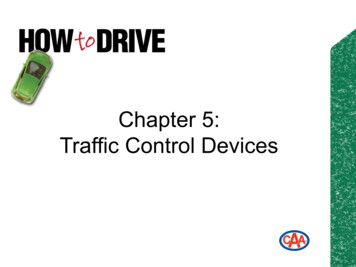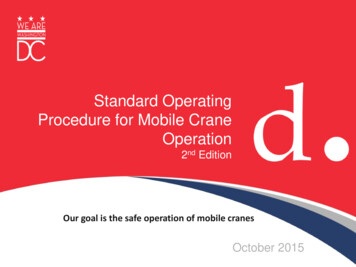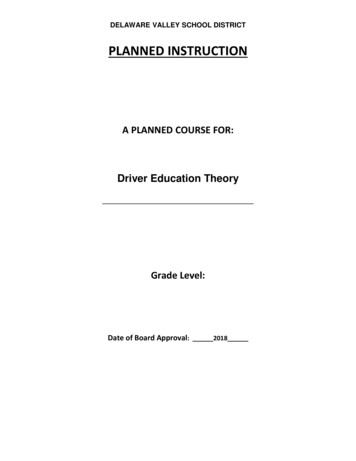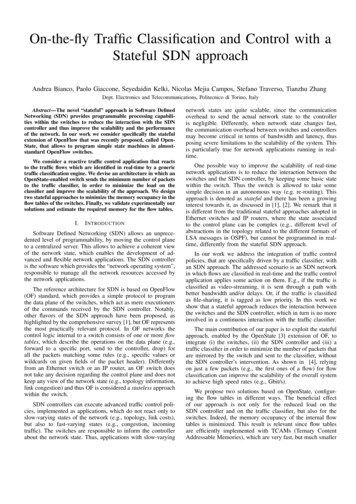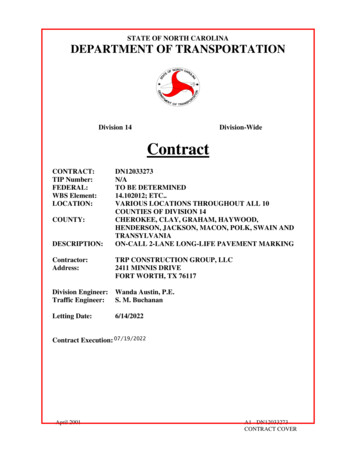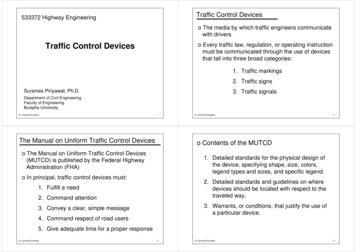
Transcription
Traffic Control Devices533372 Highway Engineeringo The media by which traffic engineers communicatewith driverso Every traffic law, regulation, or operating instructionmust be communicated through the use of devicesthat fall into three broad categories:Traffic Control Devices1. Traffic markings2. Traffic signsSurames Piriyawat, Ph.D.3. Traffic signalsDepartment of Civil EngineeringFaculty of EngineeringBurapha UniversityDr. Surames Piriyawat1The Manual on Uniform Traffic Control DevicesDr. Surames Piriyawat2o Contents of the MUTCDo The Manual on Uniform Traffic Control Devices(MUTCD) is published by the Federal HighwayAdministration (FHA)1. Detailed standards for the physical design ofthe device, specifying shape, size, colors,legend types and sizes, and specific legend.o In principal, traffic control devices must:2. Detailed standards and guidelines on wheredevices should be located with respect to thetraveled way.1. Fulfill a need2. Command attention3. Warrants, or conditions, that justify the use ofa particular device.3. Convey a clear, simple message4. Command respect of road users5. Give adequate time for a proper responseDr. Surames Piriyawat3Dr. Surames Piriyawat4
o Legal aspects of the MUTCDo Communicating with the driverThe four different categories of MUTCD guidance andinformationMessage are conveyed through the use of:1. Standard:indicated by the use of the term “shall” or “shall not” inthe statement2. Guidance:indicated by the use of the word “should” or “should not”in the statement1. Color:3. Option:usually state using the word “may” or “may not”2. Shape:o The most easily visible characteristic of a deviceo The principal colors used in traffic control devices(in Thailand) are red, yellow, green, black, and blueo Identify a particular type of information that the sign isconveying4. Support:purely information statement provided to supplyadditional information to the traffic engineer. The words“shall”, “should”, or “may” do not appear in thesestatements.Dr. Surames Piriyawato Conveying a unique message of its own5Dr. Surames Piriyawat6Traffic Markings3. Pattern:o Used in the application of traffic markingso Traffic markings fall into three broadcategories:o In general, double solid, solid, dashed and brokenlines are used4. Legend:1. Longitudinal markingso Signs often use specific legend to transmit the detailsof the message being transmitted2. Transverse markingo Legend must be kept simple and short3. Object markers and delineatorso Drivers do not divert their attention from the drivingtask in order to see and understand the specificmessage being givenDr. Surames Piriyawat7Dr. Surames Piriyawat8
o Colors and patternsColorsLines types1. Solid line1. Yellow: marking separate traffic traveling in oppositedirections2. Broken line2. White: marking separate traffic traveling in the same3. Dashed linedirections, and are used for all traverse marking4. Dotted line3. Red: marking delineate roadways that shall not beentered or used by the viewer of the marking4. Blue: marking are used to delineate parking spacesreserved for persons with disabilities5. Black: marking are used in conjunction with othermarkings on light pavementsDr. Surames Piriyawat9Solid linesDr. Surames PiriyawatDr. Surames Piriyawat10Broken and dashed lines11Dr. Surames Piriyawat12
Dotted line (1)Dr. Surames PiriyawatDotted line (2)13Example of yellow marking: yellow double solid lineand dottedDr. Surames PiriyawatDr. Surames Piriyawat14Example of yellow marking: yellow solid anddashed line15Dr. Surames Piriyawat16
Centerlineso Longitudinal marking1. Centerlines2. Lane markings3. Edge markings4. Other longitudinal markingsDr. Surames Piriyawat17Lane markingsDr. Surames PiriyawatDr. Surames Piriyawat18Lane markings: Special cases19Dr. Surames Piriyawat20
Edge markingsDr. Surames PiriyawatOther longitudinal markings21Dr. Surames Piriyawat22Stop lineso Transverse marking1. Stop lines2. Crosswalk markings3. Parking space markings4. Word and symbol markingsDr. Surames Piriyawat23Dr. Surames Piriyawat24
Parking space markingsCrosswalk markingsDr. Surames Piriyawat25Word and symbol markings (1)Dr. Surames PiriyawatDr. Surames Piriyawat26Word and symbol markings (2)27Dr. Surames Piriyawat28
Word and symbol markings (3)Dr. Surames PiriyawatWord and symbol markings (4)29o Object markers (1)Dr. Surames Piriyawat30o Object markers (2)Object markers are used to denote obstructions eitherin or adjacent to the travel wayDr. Surames Piriyawat31Dr. Surames Piriyawat32
o Delineators (1)o Delineators (2)Delineators are reflective devices mounted at a 4-ftheight on the side(s) of a roadway to help denote itsalignmentDr. Surames Piriyawat33Traffic SignsDr. Surames Piriyawat34o Regulatory signs affecting right-of-way:o Traffic signs fall into one of three major categories:1. Regulatory signs:o convey information concerning specific trafficregulationso relate to right-of-way, speed limits, lane usage,parking, or a variety of other functionsDr. Surames Piriyawat35Dr. Surames Piriyawat36
o Speed limit signs:o Turn prohibition signs:o Linear speed limitso Areawide (statutory) speed limitso Night speed limitso Lane-use signs:o Truck speed limitso Minimum speed limitsDr. Surames Piriyawat37o Parking control signs:Dr. Surames Piriyawat38o Parking control signs:o Parking:A “parked” vehicle is a stationary vehicle located at thecurb with the engine not running; whether or not the driversis in the vehicle is not relevant to this definitiono Standing:A “standing” vehicle is a stationary vehicle located at thecurb with the engine running and the driver in the caro Stopping:A “stopping” vehicle is one that makes a momentary stop atthe curb to pick up or discharge a passenger; the vehiclemoves on immediately upon completion of the pick-up ordischarge, and the driver does not leave the vehicleDr. Surames Piriyawat39Dr. Surames Piriyawat40
Condition B: Stop condition2. Warning signs: Applies in cases where the driver may be required tocome to a stop before the hazard locationo used to inform drivers about upcoming hazardsthat they might not see or otherwise discern intime to safely react Typical applications are stop ahead, yield ahead, andsignal ahead warningo There are three conditions of warning signs: A PIEV time of 2.5 sec is appliedCondition A: High judgment requiredCondition C: Deceleration to the listed advisoryspeed for the condition Applies where the road user must use extra time to adjustspeed and change lanes in heavy traffic due to acomplex driving situation Applies in cases where the road user must decelerate toa posted advisory speed to safely maneuver through thehazard Typical applications are warning signs for merging, lanedrop, and similar situations A PIEV time of 1.6 sec is assumed with a decelerationrate of 10 ft/s2 A PIEV time of 6.7 to 10 sec is assumed plus 4.5 sec foreach required maneuverDr. Surames Piriyawat41Examples of condition A warning sign:Dr. Surames PiriyawatDr. Surames Piriyawat42Examples of condition B warning sign:43Dr. Surames Piriyawat44
o Warning signs are used to inform drivers of a varietyof potentially hazardous circumstances, including:Examples of condition C warning sign: Changes in horizontal alignment Intersections Advance warning of control devices Converging traffic lanes Narrow roadways Changes in highway design Grades Roadway surface conditions Railroad crossings Entrances and crossings MiscellaneousDr. Surames Piriyawat453. Guide signs:Dr. Surames Piriyawat46o Route markerso Several general principals may be applied: If a route services a number of destinations, the mostimportant of these should be listed. No guide sign should list more than three (four may beacceptable in some circumstances) destinations on a singlesign.o Destination signs: Conventional roads Where roadways have both a name and a route number,both should be indicated on the sign if space permits. Wherever possible, advance signing of important junctionsshould be given. Confusion on the part of the driver must be avoided at allcost. Sign sequencing should be logical and shouldnaturally lead the driver to the desired route selectionsDr. Surames Piriyawat47Dr. Surames Piriyawat48
o Route markerso Destination signs: Conventional roads (Cont.)o Destination signs: Conventional roadsDr. Surames Piriyawat49Dr. Surames Piriyawat50o Service guide signso Destination signs: Freeways and expresswayso MilepostsDr. Surames Piriyawat51Dr. Surames Piriyawat52
o Recreational and cultural-interest guide signDr. Surames PiriyawatExample of installing traffic signs and marking (1)5354o Traffic signs in Thailand (1)Example of installing traffic signs and marking (2)Dr. Surames PiriyawatDr. Surames Piriyawat55Dr. Surames Piriyawat56
o Traffic signs in Thailand (2)Dr. Surames Piriyawato Traffic signs in Thailand (3)57o Traffic signs in Thailand (4)Dr. Surames PiriyawatDr. Surames Piriyawat58o Traffic signs in Thailand (5)59Dr. Surames Piriyawat60
Traffic Signalso Traffic control signalso The MUTCD defines nine type of traffic signals:The benefits of traffic control signals: Traffic control signals Increase capacity of critical intersectionmovements Pedestrian signals Emergency vehicle traffic control signals Traffic control signals for one-lane, two-way facilities Reduce the frequency and severe accidents Traffic control signals for freeway entrance ramps Provide nearly continuous movement of throughtraffic Traffic control signals for moveable bridges Provide interruptions in heavy traffic streams topermit crossing vehicular and pedestrian traffic Lane-use control signals Flashing beacons In-roadway lightsDr. Surames Piriyawat61Dr. Surames Piriyawat62Signal indications: The exampleso Signal indications: Green ball Yellow ball Red ball Flashing ball Arrow indicationsDr. Surames Piriyawat63Dr. Surames Piriyawat64
o Signal faces and visibility requirements:85th Percentile Speed(mi/h)Minimum Sight 2560715Dr. Surames Piriyawato Pedestrian signalsThe symbols used for pedestrian signals : Walking man (steady) Upraised hand (flashing) Upraised hand (steady)65Pedestrian signals: The examples (1)Dr. Surames PiriyawatDr. Surames Piriyawat66Pedestrian signals: The examples (2)67Dr. Surames Piriyawat68
Special Types of Controlo Other traffic signals Beaconso School zones In-roadway lightso Railroad crossings Lane-use control signalso Construction and maintenance zones Ramp control signals (or ramp meters)o Pedestrian and bicycle controlsDr. Surames Piriyawat69Dr. Surames Piriyawat70
Traffic Control Devices o The media by which traffic engineers communicate with drivers o Every traffic law, regulation, or operating instruction must be communicated through the use of devices that fall into three broad categories: Dr. Surames Piriyawat 2 Traffic Control Devices 1. Traffic markings 2. Traffic signs 3. Traffic signals
